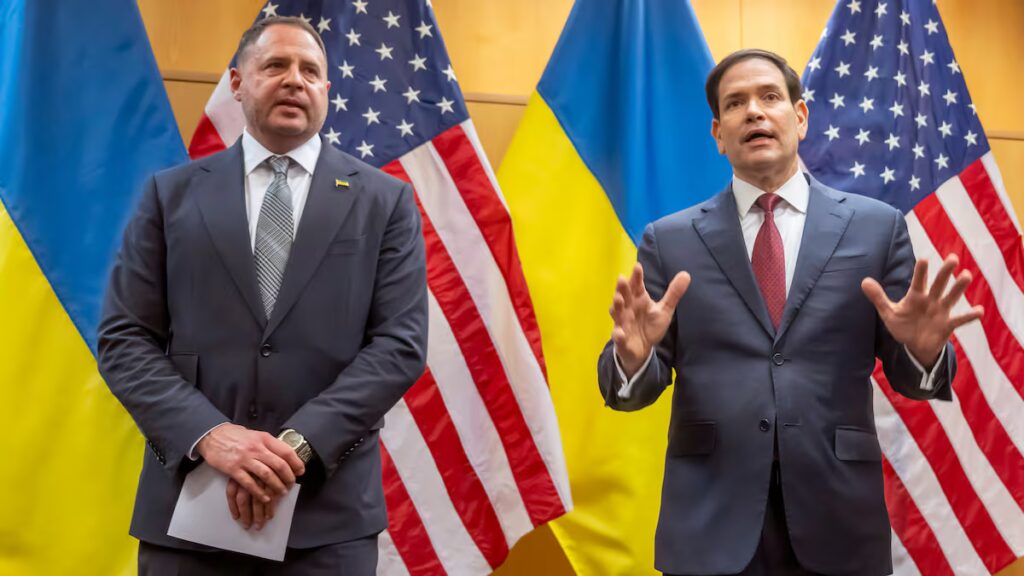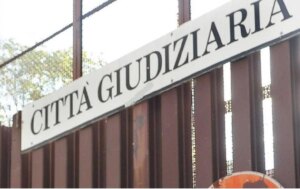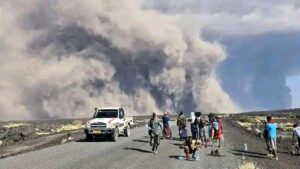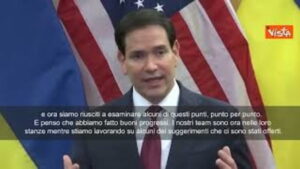
Kiev is going through a critical moment. The United States and Ukraine made progress Sunday night toward a preliminary agreement on a peace plan aimed at ending the imperialist war launched by Russia in February 2022. The blueprint — drawn up after an intense meeting in Geneva, in which the Ukrainian government was supported by European representatives, and based on the controversial American-Russian proposal — still requires technical work and “final decisions” from US President Donald Trump and Ukrainian President Volodymyr Zelenskiy, according to a joint statement released by Washington and Kiev. “As a result of the discussions, the parties have developed an updated and improved peace framework”, reads the statement released in the early hours, which opens a path of hope for the invaded country by stating that “any future agreement must fully support the sovereignty of Ukraine”.
The statement does not provide any details about this new framework, leaving many questions unanswered. Additionally, in a separate statement, the White House said that the new version of the plan included enhanced security guarantees and that the Ukrainian delegation believed the framework “reflected their national interests,” which was not included in the joint statement.
The announcement of progress in negotiations comes after Trump increased pressure on Kiev. The US president said on Sunday that Zelenskiy had “zero gratitude” for US efforts to achieve peace and criticized Europeans for continuing to buy oil from Russia while trying to support Ukraine.
Neither Ukraine nor the United States disclosed the contents of the new framework agreement, which modifies the 28-point plan outlined by Russia and the United States that called for Kiev to cede territory to the Kremlin, limit its military and give up its ambitions to join NATO. However, the foundation – the core of this preliminary agreement – remains that roadmap drawn up without the participation of Ukraine or Europe, which Kiev and its European partners have tried to modify as much as possible to limit the extent of the damage.
The Ukrainian and European idea, according to sources close to the negotiations, is to protect Ukraine with solid security guarantees that would allow them to defend the country in the event of renewed aggression (something that would serve as a deterrent for the Kremlin), as well as ensuring that Kiev is not forced to limit its military size and weapons as severely as the 28-point plan suggests. On the table is the idea of a peacetime force of 800,000 troops, rather than just 600,000 under the US-Russia roadmap. They also try to reformulate and minimize as much as possible the clauses under which the invaded country would be required to cede its territory.
Reuters reported that it had seen the document containing the European counter-proposal, built on the 28-point plan. This new text proposes, among other things, that the security guarantee offered by the United States is similar to NATO’s Article 5 (which guarantees mutual defense in case of attack); that Ukraine holds elections as soon as possible after the agreement – rather than within a fixed period of 100 days; that Ukraine’s integration into NATO depends on the consensus of all members, a consensus that does not exist – rather than forcing Kiev to include a membership waiver in its constitution; and that NATO agrees not to deploy troops to Ukraine in peacetime – rather than not deploying them at all.
As for the territorial question, instead of accepting Russia’s de facto annexation, the text simply states that Ukraine undertakes not to try to recover its sovereign territories by force.
European leaders, who have spent weeks discussing the European Commission’s proposal to transfer to Kiev 180 billion euros ($207 billion) in frozen Russian sovereign assets located in EU territory (mainly in Belgium) due to sanctions, are also demanding that these funds be handed over to Kiev as compensation and used for reconstruction.
Meanwhile, the US-Russia plan envisages that around 100 billion euros ($115 billion) of Russian assets would be invested in reconstruction and projects in Ukraine, but through a US-led format in which the US would receive 50% of the profits. Europe would also add, according to that plan drawn up without the Europeans, another 100 billion euros for reconstruction.
US Secretary of State Marco Rubio and the head of the office of the President of Ukraine Andriy Yermak described the Geneva talks as extremely significant. “We’ve had probably the most productive and meaningful meetings of the entire process so far,” Rubio said Sunday. What remains now is to both clarify the details of the new framework and evaluate the Kremlin’s reaction – and whether it will once again block efforts to end the war.
European mobilization
Europe and Kiev’s Western allies have rallied to support the invaded country in negotiations with the United States. “Any credible and sustainable peace plan should first stop the killing and end the war, without sowing the seeds of future conflict,” Ursula von der Leyen said in a video statement on Sunday. The European Commission president reiterated the position of Kiev’s Western allies that “borders cannot be changed by force” and that Ukraine should not be forced to reduce its army. “The centrality of the European Union in ensuring peace for Ukraine must be fully reflected,” insisted the EU chief executive, who took part in the G20 summit in South Africa last weekend.
At a press conference in Johannesburg after the conclusion of the G-20, Italian Prime Minister Giorgia Meloni said she had had a telephone conversation with Trump and was “willing” to amend the 28-point plan for Ukraine. Meloni argued in favor of a negotiating strategy that uses the 28-point plan as a starting point and focuses the dialogue on the elements that Europeans find problematic, rather than drawing up a comprehensive counter-proposal.
“It makes more sense to work on the existing proposal and focus on the truly crucial issues,” Meloni said. “The Russians must also give some concrete signals that they really want to achieve peace,” he added.
German Chancellor Friedrich Merz also spoke in Johannesburg about negotiations on the plan for Ukraine. The German leader said he believed the deadline set by the White House to resolve the issue was too early. “President Trump’s plan is to reach an agreement on Thursday. We are still a long way from that. This does not mean that it is completely impossible to achieve… But I am skeptical whether such an outcome is possible given the current differences,” the chancellor said on the sidelines of the G-20 summit.
Germany is, after the United States, the country that has provided the highest value of aid to Ukraine: around 38 billion euros (43 billion dollars) from the invasion until last August, according to calculations by the Kiel Institute.

Turkish President Recep Tayyip Erdoğan also expressed his opinion on the Ukrainian issue. The leader said he planned a phone call with Putin on Monday and that his intention was to discuss with him the possibility of reactivating the agreement allowing the free transit of grain shipments across the Black Sea. “I think it would be very helpful if we could start this process,” he said.
Questions about who is the author of the plan
Meanwhile, the US-Russia plan continues to come under criticism. On Saturday evening, a group of US senators (both Democrats and Republicans) claimed that Rubio had told them that the roadmap was designed by Russia. After the controversy, before leaving for Geneva, the US Secretary of State insisted that the 28-point plan was “authorized by the United States” and that it relied on “contribution” from both Russia and Ukraine.
On Saturday, Ukraine’s allies attending the G-20 summit in South Africa released a statement saying the 28-point plan requires “additional work” and that, as it stands, it would “leave Ukraine vulnerable to future attacks.”
“Together with the leaders of Europe, Canada and Japan, we declared our willingness to work on the 28-point plan despite some reservations,” Polish Prime Minister Donald Tusk wrote on X. “However, before starting our work, it would be good to know for sure who the author of the plan is and where it was created.”
Sign up to our weekly newsletter to get more English-language news coverage from EL PAÍS USA Edition





